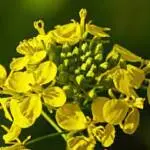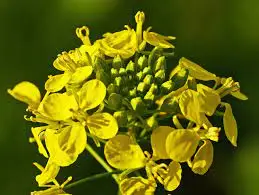No products in the cart.

Discover Mustard Crop: Cultivation, Uses, and Health Benefits
Mustard Crop: The Unsung Hero of Your Kitchen Garden
Mustard, the humble yet versatile crop, holds a special place in gardens and kitchens alike. From its historical significance to its modern-day uses, there’s much to explore about this fascinating plant. Whether you’re a gardening enthusiast or simply curious about expanding your culinary horizons, this article will cover everything you need to know about mustard crops.

Table of Contents
| Sr# | Headings |
|---|---|
| 1 | What is Mustard? |
| 2 | Types of Mustard Crops |
| 3 | Growing Conditions |
| 4 | Planting and Cultivation |
| 5 | Caring for Mustard Plants |
| 6 | Harvesting and Storage |
| 7 | Culinary Uses |
| 8 | Health Benefits |
| 9 | Mustard in Folklore and Tradition |
| 10 | Mustard in Modern Research |
| 11 | Environmental Impact |
| 12 | Common Pests and Diseases |
| 13 | Fun Facts About Mustard |
| 14 | Conclusion |
| 15 | Frequently Asked Questions (FAQs) |
What is Mustard?
Mustard is a plant belonging to the Brassicaceae family, which also includes cabbage, broccoli, and Brussels sprouts. It’s primarily grown for its seeds, which are used as a spice, but its leaves are edible too, often used in salads.
Types of Mustard Crops
Mustard comes in several varieties, each with its own unique flavor profile:
Yellow Mustard
Yellow mustard, or Sinapis alba, is known for its mild taste and is commonly used in American mustard condiments.
Brown Mustard
Brown mustard, or Brassica juncea, has a spicier flavor and is often used in European and Asian cuisines.
Black Mustard
Black mustard, or Brassica nigra, has a pungent taste and is commonly found in Indian cooking.
Growing Conditions
To grow healthy mustard plants, you’ll need:
- Sunlight: Mustard plants thrive in full sun.
- Soil: Well-drained, fertile soil is best.
- Water: Regular watering is crucial, especially during dry periods.
- Temperature: Cool to moderate temperatures are ideal.
Planting and Cultivation
Planting Mustard Seeds
- Seed Depth: Plant seeds 1/4 inch deep in rows.
- Spacing: Space rows 6-18 inches apart, depending on the variety.
- Germination: Seeds typically germinate in 3-10 days.
Cultivation Tips
- Weeding: Keep the area around mustard plants weed-free.
- Fertilization: Apply a balanced fertilizer during planting.
- Mulching: Mulch can help retain moisture and suppress weeds.
Caring for Mustard Plants
Mustard plants are relatively easy to care for:
- Watering: Keep the soil evenly moist.
- Thinning: Thin plants to 6-10 inches apart once they reach 2 inches in height.
- Pest Control: Monitor for pests like aphids and caterpillars.
Harvesting and Storage
Harvesting Mustard
- Timing: Harvest when seeds are fully developed and dry on the plant.
- Cutting: Cut the mustard plants near the ground.
- Drying: Hang plants upside down in a dry, well-ventilated area.
Storage
- Seeds: Store seeds in a cool, dry place in an airtight container.
- Leaves: Refrigerate fresh leaves for up to one week.
Culinary Uses
Mustard Seeds
Mustard seeds are used in various forms:
- Condiments: Ground into mustard paste for sauces.
- Pickling: Used in pickling recipes.
- Spice: Whole seeds for seasoning.
Mustard Leaves
- Salads: Add fresh leaves to salads for a peppery bite.
- Cooking: Sautee or steam leaves as a side dish.
Health Benefits
Mustard offers several health benefits:
- Nutrition: High in minerals like selenium and magnesium.
- Antioxidants: Contains phytonutrients that protect against oxidative stress.
- Digestion: Aids in digestion and can stimulate appetite.
Mustard in Folklore and Tradition
Throughout history, mustard has been:
- Symbolic: Representing growth and prosperity.
- Culinary: Used in ancient Roman and Greek cuisines.
- Medicinal: Used in traditional medicine for its healing properties.
Mustard in Modern Research
Research Findings
- Antimicrobial Properties: Studies suggest mustard seeds have antimicrobial effects.
- Anti-inflammatory: Compounds in mustard may have anti-inflammatory benefits.
- Cancer Prevention: Early research indicates potential cancer-fighting properties.
Environmental Impact
Mustard has positive environmental effects:
- Cover Crop: Acts as a natural soil fumigant and weed suppressor.
- Biodiversity: Supports beneficial insects and pollinators.
- Soil Health: Improves soil structure and nutrient content.
Common Pests and Diseases
Pests
- Aphids: Small, sap-sucking insects that can affect mustard plants.
- Cabbage Worms: Caterpillars that feed on mustard leaves.
Diseases
- White Rust: Fungal disease affecting leaves.
- Downy Mildew: Fungal infection that thrives in wet conditions.
Fun Facts About Mustard
- Ancient Origins: Mustard seeds have been found in Egyptian tombs dating back to 3000 BC.
- Global Appeal: Mustard is consumed worldwide in various forms.
- Culinary Delight: The city of Dijon, France, is famous for its mustard.
Conclusion
In conclusion, mustard is more than just a condiment—it’s a versatile plant with deep historical roots and significant health benefits. Whether you’re growing it in your garden or enjoying it on your plate, mustard adds spice and flavor to life.
Frequently Asked Questions (FAQs)
What nutrients are in mustard seeds?
Mustard seeds are rich in minerals like calcium, iron, magnesium, and zinc, as well as dietary fiber and protein.
How do you use mustard seeds in cooking?
Mustard seeds can be ground into powder for sauces, pickled whole, or used as a seasoning in various dishes.
Can mustard plants grow indoors?
Yes, mustard plants can be grown indoors if they receive adequate sunlight and are kept in well-draining soil.
How long do mustard seeds take to germinate?
Mustard seeds typically germinate within 3-10 days under optimal conditions.
What are the different flavors of mustard?
Mustard flavors range from mild (yellow mustard) to spicy (brown and black mustard), catering to different culinary preferences.
This comprehensive guide covers everything you need to know about mustard crops. Whether you’re intrigued by its culinary uses, fascinated by its health benefits, or interested in its historical significance, mustard is a crop worth exploring in your garden and your kitchen.
Go and turn on towards organic farming to save future and thire save childs:
Elevate Plant Growth with Premium Bone Powder – Buy Now!
Organic Cow Dung Compost: Transform Your Garden Naturally
Premium Humic Acid for Healthy Plants | Enhance Soil & Boost Growth
Boost Plant Growth Naturally with Mustard Cake | Organic Fertilizer
Transform Your Garden with NPK Fertilizer | Boost Growth by 30%
Premium Perlite for Enhanced Gardening | Buy Now
Live Earthworms with Enhance Your Garden (soil health)
1 Neem Khali: Unveiling the Wonders of Nature
1Transform your garden with vermiwash-buy now
1 Premium quality Vermicompost [ केचुआ खाद ]
Follow us:
Tagged Inmustard crop




